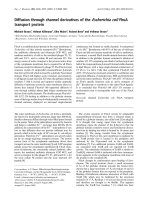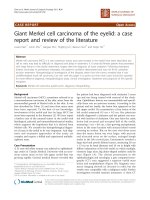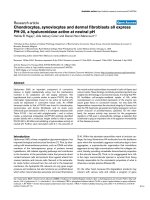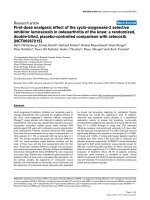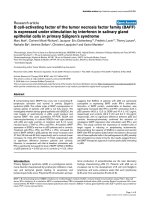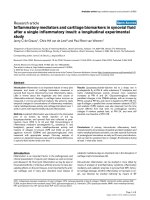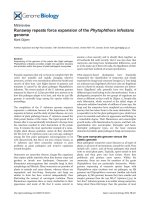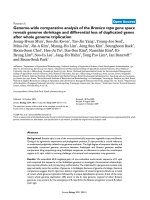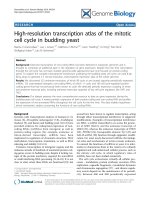Báo cáo y học: "omparative Efficacy and Tolerability of 5-Loxin® and Aflapin® Against Osteoarthritis of the Knee: A Double Blind, Randomized, Placebo Controlled Clinical Study"
Bạn đang xem bản rút gọn của tài liệu. Xem và tải ngay bản đầy đủ của tài liệu tại đây (672.85 KB, 12 trang )
Int. J. Med. Sci. 2010, 7
366
I
I
n
n
t
t
e
e
r
r
n
n
a
a
t
t
i
i
o
o
n
n
a
a
l
l
J
J
o
o
u
u
r
r
n
n
a
a
l
l
o
o
f
f
M
M
e
e
d
d
i
i
c
c
a
a
l
l
S
S
c
c
i
i
e
e
n
n
c
c
e
e
s
s
2010; 7(6):366-377
© Ivyspring International Publisher. All rights reserved
Research Paper
Comparative Efficacy and Tolerability of 5-Loxin
®
and Aflapin
®
Against
Osteoarthritis of the Knee: A Double Blind, Randomized, Placebo Controlled
Clinical Study
Krishanu Sengupta
1
, Alluri V. Krishnaraju
1
, Amar A. Vishal
2
, Artatrana Mishra
3
, Golakoti Trimurtulu
1
,
Kadainti VS Sarma
4
, Smriti K Raychaudhuri
5
, Siba P Raychaudhuri
5
1. Laila Impex R&D Center, Jawahar Autonagar, Vijayawada, 520 007, India
2. Department of Orthopedics, Alluri Sitarama Raju Academy of Medical Sciences (ASRAM), National Highway 5, Eluru,
534 002, India
3. Department of Internal Medicine, Alluri Sitarama Raju Academy of Medical Sciences (ASRAM), National High way 5,
Eluru, 534 002, India
4. Department of Statistics, Prakasam Road, SV University, Tirupati, 517 592, India
5. Department of Medicine, Division of Rheumatology, Allergy and Immunology, School of Medicine, U C Davis and VA
Medical Center Sacramento, Hospital Way, Mather, California 95655, USA
Corresponding author: Siba P Raychaudhuri,
Received: 2010.09.01; Accepted: 2010.10.15; Published: 2010.11.01
Abstract
Aflapin
®
is a novel synergistic composition derived from Boswellia serrata gum resin (Indian
Patent Application No. 2229/CHE/2008). Aflapin is significantly better as an anti-inflammatory
agent compared to the Boswellia extracts presently available in the market. A 90-d a y ,
double-blind, randomized, placebo-controlled study was conducted to evaluate the com-
parative efficacy and tolerability of 5-Loxin
®
and Aflapin
®
in the treatment of osteoarthritis
(OA) of the knee (Clinical trial registration number: ISRCTN80793440). Sixty OA subjects
w e r e i n c l u d e d i n t h e s t u d y . T h e s u b j e c t s r e c e i v e d e i t h e r 1 0 0 m g ( n = 2 0 ) o f 5 -Loxin
®
o r 1 0 0 m g
(n=20) of Aflapin
®
or a placebo (n=20) daily for 90 days. Each patient was evaluated for pain
and physical functions by using the standard tools (visual analog scale, Lequesne's Functional
Index, and Western Ontario and McMaster Universities Osteoarthritis Index) at the baseline
(day 0), and at days 7, 30, 60 and 90. A battery of biochemical parameters in serum, urine and
hematological parameters in citrated whole blood were performed to assess the safety of
5-Loxin
®
and Aflapin
®
i n O A s u b j e c t s . F i f t y s e v e n s u b j e c t s c o m p l e t e d t h e s t u d y . A t t h e e n d o f
the study, both 5-Loxin
®
and Aflapin conferred clinically and statistically significant im-
provements in pain scores and physical function scores in OA subjects. Interestingly, signifi -
c a n t i m p r o v e m e n t s i n p a i n s c o r e a n d f u n c t i o n a l a b i l i t y w e r e r e c o r d e d a s e a r l y a s 7 d a y s a f t e r
initiation of the study in the treatment group supplemented with 100 mg Aflapin. Corrobo-
rating the improvements in pain scores in treatment groups, our in vitro studies provide
evidences that Aflapin
®
is capable of inhibiting cartilage degrading enzyme MMP-3 and has the
potential to regulate the inflammatory response by inhibiting ICAM-1. Aflapin
®
a n d 5-Loxin
®
reduce pain and improve physical functions significantly in OA subjects. Aflapin exhibited
better efficacy compared to 5-Loxin
®
. In comparison with placebo, the safety parameters
were almost unchanged in the treatment groups. Hence both 5-L o x i n
®
and Aflapin
®
are safe
for human consumption.
Key words: Aflapin
®
, 5-Loxin
®
, Boswellia serrata, anti-inflammation, osteoarthritis and clinical
study.
Int. J. Med. Sci. 2010, 7
367
Introduction
Osteoarthritis (OA) is the commonest form of
arthritic disease, characterized by articular cartilage
degradation with an accompanying peri-articular
bone response [1,2]. OA affects nearly 21 million
people in the USA, accounting for 25% of visits to
primary care physicians. It is estimated that 80% of
the population will have radiographic evidence of OA
by age 65 years, although only 60% of those will be
symptomatic [3]. Clinical manifestations of OA of the
knee include pain in and around the joint, stiffness of
the joint, crepitation on motion and limited joint mo -
tion, among others [4]. Current recommendations for
managing OA focus on relieving pain and stiffness
and improving physical function as important goals
of therapy [5,6]. Currently available medication re-
gimens for most cases include nonopioid analgesics
such as acetaminophen and nonsteroidal an -
ti-inflammatory drugs (NSAIDs) including cyc-
lo-oxygenase II inhibitors. These pharmaceutical
agents can reduce both pain and inflammation quite
effectively, but long term use of NSAIDs has been
found to associate with enhanced risk for gastrointes-
tinal bleeding, hypertension, congestive heart failure
and renal insufficiency, among other adverse effects
[7-9]. Because of the high incidence of adverse events
associated with both nonselective and cyc-
lo-oxygenase II selective NSAID therapy, effective
and safer alternative treatments for OA are urgently
needed. In recent years, the gum resin extracted from
the ancient herb, Boswellia serrata has gained lot of
attention as a potent anti-inflammatory, anti-arthritic
and analgesic agent [10,11]. 3-O-acetyl-11-keto-beta-
boswellic acid (AKBA) is the most active component
of Boswellia extract and has been demonstrated to be a
potent inhibitor of 5-lipoxygenase (5-LOX), a key en-
zyme in the biosynthesis of leukotrienes from ara-
chidonic acid in the cellular inflammatory cascade
[12,13]. 5-Lo xin
®
is a novel B. serrata extract enriched
to 30% AKBA (US Patent publication no.:
2004/0073060A1). Affimatrix gene chip analysis
demonstrated that 5-Loxin
®
can potently inhibit tu-
m o r n e c r o s i s f a c t o r α ( T N F α ) i n d u c e d g e n e expression
of matrix metalloproteinases (MMPs), adhesion mo-
lecules such as intercellular adhesion molecule-1
(ICAM-1) and vascular cell adhesion molecule-1
(VCAM-1); and mediators of apoptosis in human mi-
crovascular endothelial cells [14, 15]. Cell based in
vitro studies suggest that 5-L o xi n
®
ca n inh i b it
pro-inflammatory cytokines such as tumor necrosis
factor-α, interleukin-1β [16]. In the carragee-
nan-induced inflammation model, 5-L oxin
®
treatment
yielded significant improvement in paw inflamma-
tion in albino Wistar rats. 5-L o x in
®
also exhibited sig-
nificant Anti-arhtritic efficacy in FCA induced model
of Sprague-Dawley rats [14, 15]. Extensive acute and
dose dependent subchronic safety studies on rats
demonstrated that 5-Loxin
®
is safe even at dose levels
2,000 to 3,000 times higher than the human equiva-
lence dose [17]. In addition, 5-L oxi n
®
was found to be
non genotoxic as per the standard AMES bacterial
reverse mutation assay, chromosomal aberration test
in Chinese hamster cells and mouse peripheral blood
micronucleus assay [18-21] The efficacy and tolerabil-
ity of 5-Loxin® was assessed in a previous double
blind placebo controlled clinical study. The supple-
mentation of 5-Lox i n
®
was well tolerated and its effi-
cacy against osteoarthritis was found to be statistically
significant. The dose dependent efficacy of 5-L o xin
®
was assessed against pain, joint stiffness, mobility and
a cartilage degrading enzyme MMP-3 in OA subjects
[22]. Aflapin
®
is a novel synergistic composition de-
rived from Boswellia serrata gum resin (Indian Patent
Application No. 2229/CHE/2008). Interestingly it
was found that the oral bioavailability of AKBA from
Aflapin
®
was better compared to that of 5-L o xin
®
.
Aflapin exhibited better 5-lipoxygenase inhibitory
activity and MMP-3 inhibition. Various in vitro a nd In
vivo studies were performed to compare efficacy of
Aflapin and 5-L o xin
®
. These studies proved Aflapin
to be more efficacious compared to 5-Loxin
®
(to be
presented in a separate communication). The broad
spectrum safety of Aflapin was tested using a battery
of safety studies conducted according to OECD
guidelines and it was found to be safe [23]. Although
a significant number of clinical study reports support
the anti-inflammatory and anti-arthritic properties of
Boswellia extract [24-27], no human clinical studies
were done to prove the efficacy and tolerability of
Aflapin in osteoarthritis. Hence in the present clinical
study we sought to evaluate the comparative efficacy
and tolerability of 5-L o xin
®
and Aflapin
®
in the
treatment of OA of the knee.
Materials and Methods
Study materials
BE-30 (5-L o x in
) is a novel Boswellia serrata ex-
tract standardized to contain at least 30 percent
3-O-Acetyl-11-keto-β-boswellic acid (AKBA) using a
selective enrichment process (Indian patent # 205269).
The process involves selective enrichment of AKBA
while simultaneously suppressing the concentration
of triterpene compounds that are less active and those
that antagonize the activity of AKBA. Aflapin is a
Int. J. Med. Sci. 2010, 7
368
novel synergistic composition containing B. serrata
extract selectively enriched with AKBA and B. serrata
non-volatile oil. The non-volatile oil was prepared
using a special process (PCT application #
PCT/IN2009/000505) involving selective removal of
Boswellic acids followed by removing volatiles under
high vacuum. The composition was standardized to
contain at least 20% AKBA.
Study design
This trial was performed at Alluri Sitarama Raju
Academy of Medical Sciences (ASRAM), Eluru,
Andhra Pradesh, India from July 2008 to December
2008 (clinical trial registration number:
ISRCTN80793440). The study protocol was evaluated
and approved by the ASRAM Institutional Review
Board (IRB). An overview of the clinical study is pro-
vided in Figure 1. Briefly, 186 subjects out of 283 at -
tending the orthopaedic outpatient department of the
A S R A M h o s p i t a l w e r e s e l e c t e d i n t h e f i r s t p h a s e o f t h e
screening procedure, based on the signs, symptoms
and radiological changes consistent with OA. A total
of 60 subjects suffering for more than 3 months with
medial tibio-femoral OA were selected using inclu-
sion/exclusion criteria summarized in Table 1. All
subjects signed the IRB approved consent form. Sub-
jects, who were otherwise healthy, were aged 40 years
or older and had a diagnosis of OA, fulfilling the
American College of Rheumatology classification cri-
teria [4]. After recruitment, the subjects were ran-
domly distributed into three groups. The demo-
graphic data and baseline characteristics are summa-
rized in Table 2.
Figure 1: Flow chart of the subjects who participated in the clinical trial. Evaluations of physical activity and pain scores,
serum biochemistry, hematology, and urine biochemistry were done at baseline (day 0) and on days 7, 30, 60 and 90 during
follow up.
Int. J. Med. Sci. 2010, 7
369
Table 1: Inclusion/exclusion criteria
Criteria Details
Inclusion Subjects must understand risks and benefits of the protocol and be able to give informed consent
Male and female subjects aged 40 to 80 years
Females of child-bearing potential must agree to use an approved form of birth control and to have a negative pregnancy test
result
Unilateral or bilateral osteoarthritis of the knee for more than 3 months
Visual analogue scale score during the most painful knee movement between 40 and 70 mm after 7 days of withdrawal of
usual medication
Lequesne's Functional Index score greater than 7 points after 7 days of withdrawal of usual medication
Ability to walk
Availability for the duration of the entire study period
Exclusion History of underlying inflammatory arthropathy or severe rheumatoid arthritis
Hyperuricaemia (>440 μmol/l) and/or past history of gout
R e c e n t i n j u r y i n t h e a r e a a f f e c t e d b y o s t e o a r t h r i t i s o f t h e k n e e ( p a s t 4 m o n t h s ) a n d e x p e c t a t i o n o f s u r g e r y i n t h e n e x t 4 m o n ths
Intra-articular corticosteroid injections within the preceding 3 months
Hypersensitivity to nonsteroidal anti-inflammatory drugs, abnormal liver or kidney function tests, history of peptic ulceration
and upper gastrointestinal hemorrhage, congestive heart failure, hypertension, cancer, hyperkalaemia
Major abnormal findings on complete blood count, history of coagulopathies, hematological or neurological disorders
High alcohol intake (>2 standard drinks per day)
Pregnant, breastfeeding, or planning to become pregnant during the study
Use of concomitant prohibited medication other than ibuprofen
Obesity (body mass index > 30 kg/m2)
Table 2: Demographic data and baseline characteristics of the subjects
Characteristics Placebo
(n = 19)
100 mg/day 5-Loxin
®
(n = 19) 100 mg/day Aflapin
®
(n = 19)
Sex (male/female; n) 9/10 3/16 7/12
Age (years) 52.4 ± 7.5 51.6 ± 9.9 53.2 ± 7.9
Body weight (kg) 62.4 ± 14.9 57.7 ± 10.5 59.1 ± 7.4
Body mass index (kg/m2) 25.3 ± 4.4 25.1 ± 3.8 25.2 ± 3.0
Visual analog score 47.7 ± 6.5 48.2 ± 6.1 47.7 ± 7.3
Lequesne's Functional Index 12.3 ± 2.8 12.4 ± 2.6 12.0 ± 2.4
WOMAC scores
Pain subscale 44.7 ± 11.5 46.1 ± 7.6 45.0 ± 13.3
Stiffness subscale 39.5 ± 11.2 39.5 ± 11.2 39.5 ± 13.3
Function subscale 42.0 ± 10.3 43.1 ± 7.8 42.0 ± 8.4
Before study enrollment, subjects were required
to be taking an NSAID at prescription strength for at
least 30 days or acetaminophen 1,200 to 4,000 mg/day
o n a r e g u l a r b a s i s ( a t l e a s t 2 5 o f t h e p r e c e d i n g 3 0 d a y s )
with a history of therapeutic benefit. Eligibility re-
quires subjects to meet specific flare criteria upon
medication washout. At screening, subjects had to
demonstrate a visual analog scale (VAS) score be-
tween 40 and 70 mm during the most painful knee
movement, and Lequesne's Functional Index (LFI)
score greater than 7 points after 7-day withdrawal of
usual medication.
A total of 60 selected subjects with symptoms of
moderate to mild OA were recruited into the study.
Each subject was randomly assigned to a treatment
group using a randomization table generated using
validated computer software CODE; IDV, Gauting,
Germany. The clinical trial pharmacist and statistician
ensured that treatment codes remained confidential.
The subjects were distributed into three groups: pla-
cebo (n=20); 5-Loxin® group, in which subjects re-
ceived 50 mg encapsulated 5-Loxin
®
twice daily
(n=20); and Aflapin group, in which subjects received
50 mg encapsulated Aflapin
®
twice daily (n=20).
S u b j e c t s i n t h e p l a c e b o g r o u p r e c e i v e d t w o c a p s u l e s o f
similar color, taste and appearance but filled with
suitable exicipient. Each subject completed a ques-
tionnaire, providing details regarding demographics,
medical history and nutritional status, at the baseline
evaluation and during the follow-up evaluations on
days 7, 30, 60 and 90. At the baseline evaluation, and
at each visit during the 90-day follow up period, al l
Int. J. Med. Sci. 2010, 7
370
subjects were assessed for pain and physical function
using validated pain scores. Various parameters of
serum biochemistry, hematology and urine analysis
were carried out on each evaluation day. Safety was
monitored by clinical and laboratory assessments
conducted during the study visits and sub-
ject-reported adverse experiences.
Functional disability and pain score evaluation
Functional disability was assessed by the inves-
tigators at baseline and on each follow-up visit (days
7, 30, 60 and 90). Questionnaire-based assessment of
pain, stiffness and physical function were done using
the Western Ontario and McMaster Universities Os-
teoarthritis Index (WOMAC) index [28], LFI [29] and
VAS [30]. The WOMAC index produces scores for
three subscales: pain, stiffness and physical function.
The pain, stiffness and function subscales of the
WOMAC were normalized to a scale of 0 to 100 units
(NU) [31]. The pain subscale was the average of the
first five questions of WOMAC and measured using
the NU scale from 0 ('no pain') to 100 ('extreme pain')
for each question. The stiffness subscale was the av -
erage of questions 6 and 7, measured using the NU
scale from 0 ('no stiffness') to 100 ('extreme stiffness')
for each question. The physical function subscale was
the average of questions 8 through 24 of the WOMAC
and measured by NU scale from 0 ('no difficulty') to
100 ('extreme difficulty') for each question. Analyses
of these end-points were based upon the
time-weighted average change from baseline over 90
days.
Hematological and biochemical evaluations
For assessment of safety of 5-Loxi n
®
and Afla-
pin
®
, several parameters were evaluated in serum,
urine and whole blood of all subjects at each visit of
the study duration. Serum biochemical parameters
and hematological parameters were measured using
an automated analyzer (HumaStar 300) and a hema-
tological counter (Humacount, Human, Wiesbaden,
Germany). The urine analysis was carried out using
UroColor™10 Dip Sticks and Urometer 600 (Standard
Diagnostics, Kyonggi-do, Korea) and by sediment
analysis using microscopy.
I n v i t r o s t u d i e s t o i d e n t i f y m e c h a n i s m s o f a c t i o n s
of Aflapin: Effect on expression of ICAM-1 and
MMP3
Adhesion molecule (ICAM-1) expression on
endothelial cells: 20,000 Endothelial cell (HDMEC,
Lonza Inc., USA ) p e r w e l l i n q u a d r u p l i c a t e w e l l s w e r e
treated with medium, vehicle, TNFα ( 2 0 n g / ml ) ,
TNFα (20ng/ml) with 5-L oxin
®
or Aflapin
®
(4µg/ml
each) for 24 hour then ICAM-1 ELISA was performed
on fixed cells of these wells as per our established
protocol [32].
Effect on secretion of MMP3 in TNFα induced
human chondrocyte: Human primary Chondrocytes
(HCH) was procured from Promo Cell GmbH (Hei-
delberg, Germany). HCH cells were cultivated in the
growth medium (Ready-to-use; Promo Cell, Catalog
number C-27101) supplemented with Supplement
Mix (Promo Cell, Catalog number C-39635). Equal
number of HCH cells was plated in each well of
96-well cell culture plate. Cells were treated with 5
ng/ml of TNFα in presence or absence of different
concentrations of 5-Loxin
®
or Aflapin for 24h. Vehicle
control cultures received 0.01% DMSO (v/v). MMP-3
was quantitatively measured in the cell culture su-
pernatant by human MMP-3 EIA kit (R&D Systems,
USA) following manufacturer’s instructions.
Rescue medication
Subjects were prescribed ibuprofen 400 mg tab-
lets (maximum 400 mg thrice daily; total 1,200 mg) as
rescue analgesia during the study based on pain in-
tensity reported to the study physician by the patient.
However, the subjects were instructed not to take
medicine at least 3 days before each evaluation. No
other pain relieving interventions were allowed dur-
ing the study period.
Statistical analysis
Detailed statistical analyses were performed us-
ing SAS software to evaluate the efficacy of 5-Loxin
®
and Aflapin
®
i n c o m p a r i s o n w i t h t h e placebo group in
terms of improvement in pain and physical function
scores at baseline and on days 7, 30, 60 and 90 of
treatment and serum MMP-3 levels at baseline and on
day 90 of treatment. Pair-wise changes were ex-
amined by carrying out a least significant difference
test for all possible pairs. The significance of the ef-
fects of the treatment groups was compared by using
one-way analysis of variance (ANOVA) followed by
Tukey's multiple comparison tests. Results with
P<0.05 are considered statistically significant. This is a
three-arm (5-Loxin
®
, Aflapin
®
and placebo), rando-
m i z e d , d o u b l e -blind, placebo-controlled, single-centre
trial conducted over 90 days. The trial's primary ob -
jective was to determine the effects of 5-L o x i n
®
an d
Aflapin
®
on pain, physical function and joint stiffness.
For power calculations, the estimates for variability
and assumed mean changes for each treatment group
were based on results from previous place-
bo-controlled studies of celecoxib, etoricoxib and ro-
fecoxib conducted in subjects with OA [33-36]. We
believe that an intervention that gives an average im-
provement of mean change ± 1 standard deviation,

